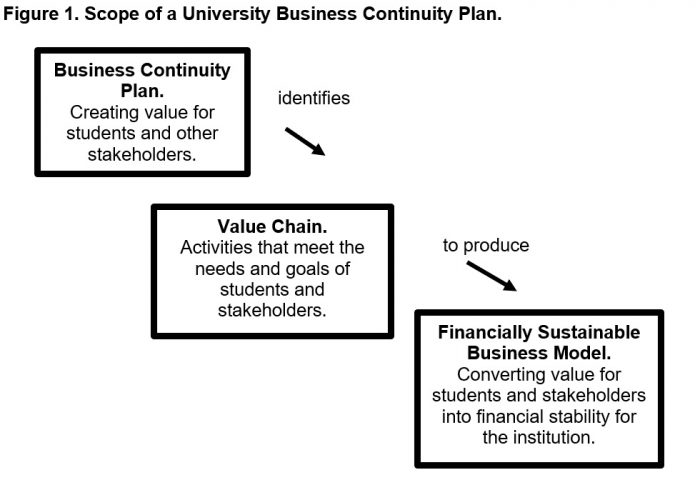Can Business Continuity Planning Stave Off Higher Ed’s COVID-19 Revenue Nightmare?
In the midst of a crisis in higher education in the United States, we might ask a question using the old reliable multiple-choice format.
Which of the following is the goal of a college or university?
A. Prepare individuals to be clergymen, doctors, or lawyers.
B. Improve agriculture.
C. Create factory and office workers.
D. Something else.
We’ll get to the answer in a minute or two.
In the meantime, a newly-published book titled “The Post-pandemic College” joins a chorus of voices recommending new risk management behaviors for colleges and universities. These include:
- Take advantage of the benefits of online teaching.
- Adopt flexible course structures and delivery models.
- Offer courses that are more relevant and timely.
- Expand opportunities that enhance teamwork and career-readiness.
Many presidents, deans, and professors see the need for change. They should get in the game, developing or revising a sustainable business model accompanied by a viable value chain.
Technical jargon? Not at all. Just simple risk management.
- Business Model. A statement that shows how an organization creates and delivers value and is rewarded for bringing it to others.
- Value Chain. A set of activities that an organization performs to deliver a valuable product or service to willing buyers.
But wait a minute. Don’t most colleges and universities have published descriptions of their mission, vision, and values?
Of course they do.
-
- Mission statement. Our University educates . . . learners . . . to excel intellectually, lead ethically, serve compassionately . . .
- Vision statement. Our University has a historic opportunity to . . .
- Values statement. We are an academic community committed to high standards . . . excellence . . . preparing students for lives of learning, leadership, and service.
Good stuff all, but that’s about it. These statements do not answer urgent questions from potential students:
- How am I, or my family, going to pay for college?
- Why do I have to take so many courses that don’t interest me?
- Why do so many courses repeat the same material I learned in high school?
- How do I blend together attending college and holding down a job?
The survival of many colleges and universities currently depends on their success with business continuity planning — the process of developing or revising an obsolete business model and value chain. Figure 1 shows its scope.

Universities can acknowledge the urgency for action by creating a Business Continuity Planning Task Force. These individuals can identify and address problems or practices that need to be revised to achieve sustained long-term continuity.
The task force should be led by someone who understands risk management and who has no vested interest in preserving cherished but obsolete traditions that endanger the institution.
From this recommendation, we return to our multiple choice question.
Is the goal of a college or university to prepare individuals to be clergymen, doctors, or lawyers? The answer is yes, particularly in the period 1740 to 1820.
Is it to improve agriculture? True, starting around 1820.
Is it to create factory and office workers? True, starting about 1870, expanding after 1920, and going crazy with technology since the birth of the Internet.
Today, the best answer is “something else.” The primary goal is survival. For many colleges and universities this means creating a sustainable risk management strategy. It can start with something simple: Our university works to understand student needs and motivations and match them with programs that delivers the knowledge and skills they need in a financial package that provides sustainable long-term viability for the school.
Colleges and universities that pursue this goal supported by the right value chain increase their chances for long-term survival. &










